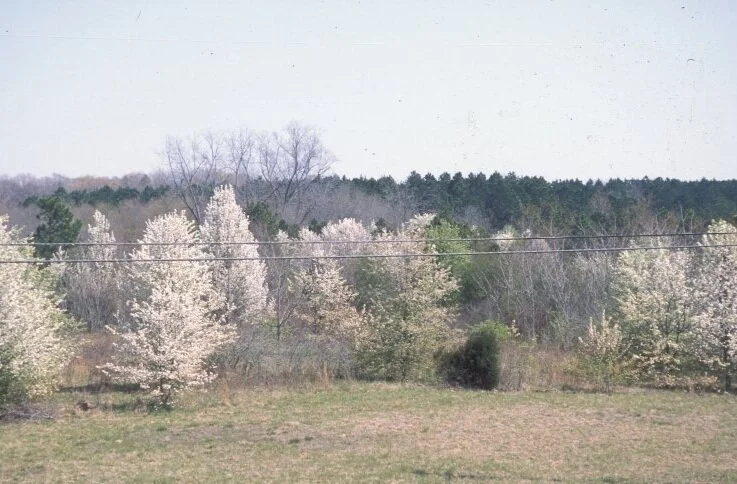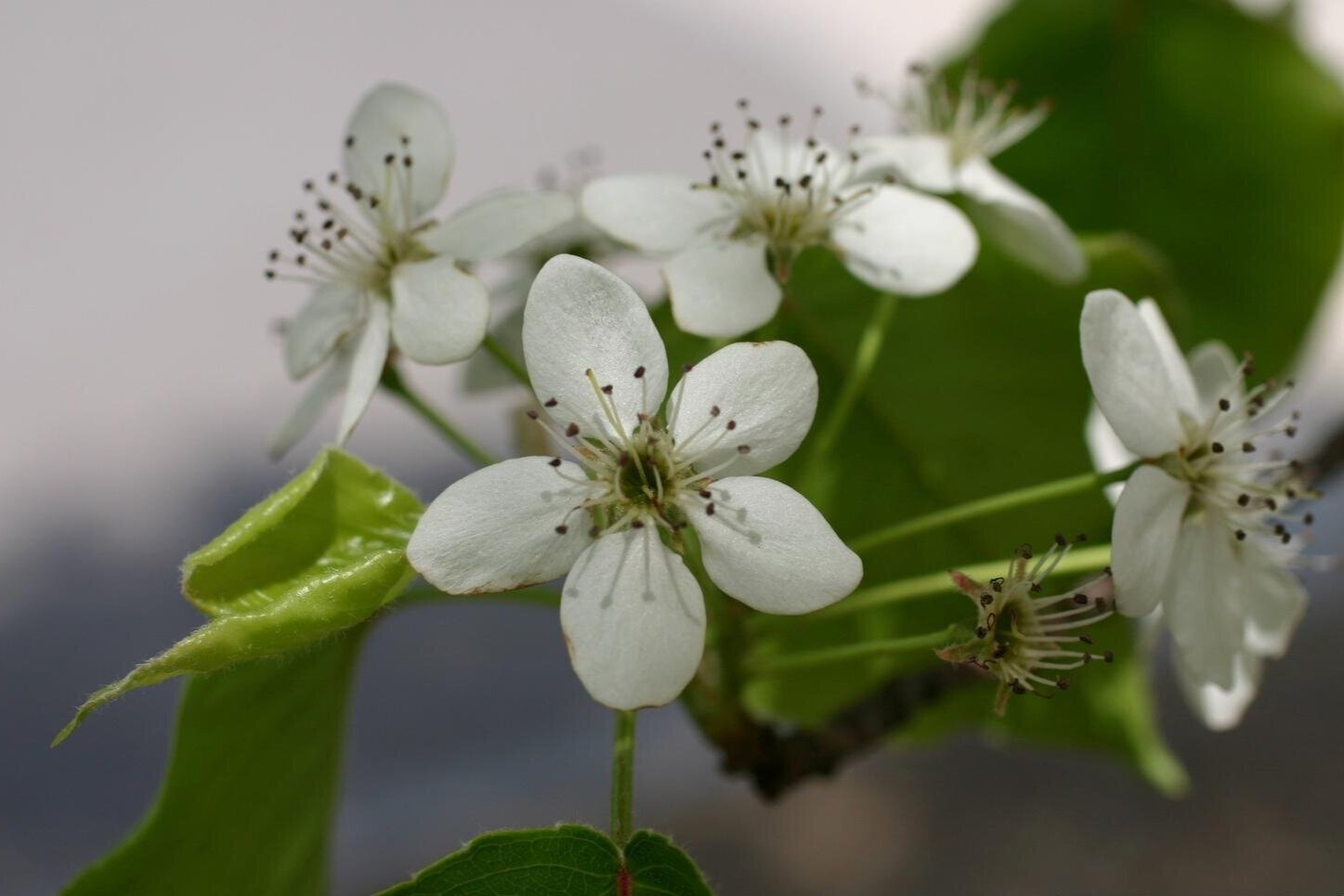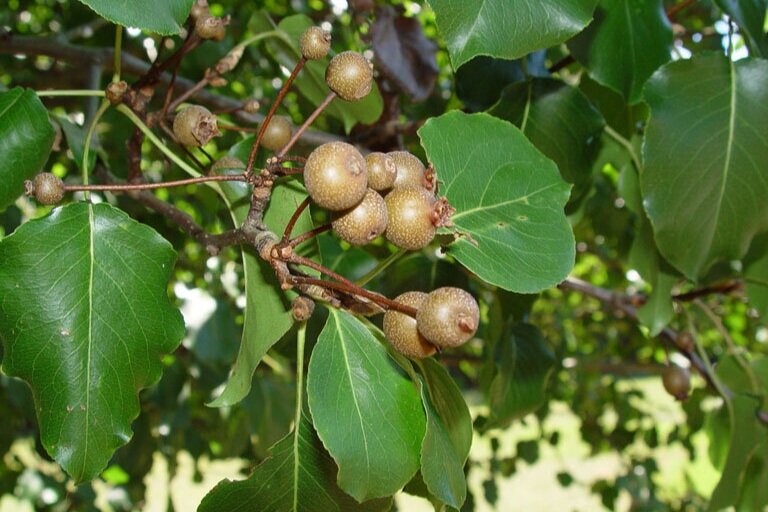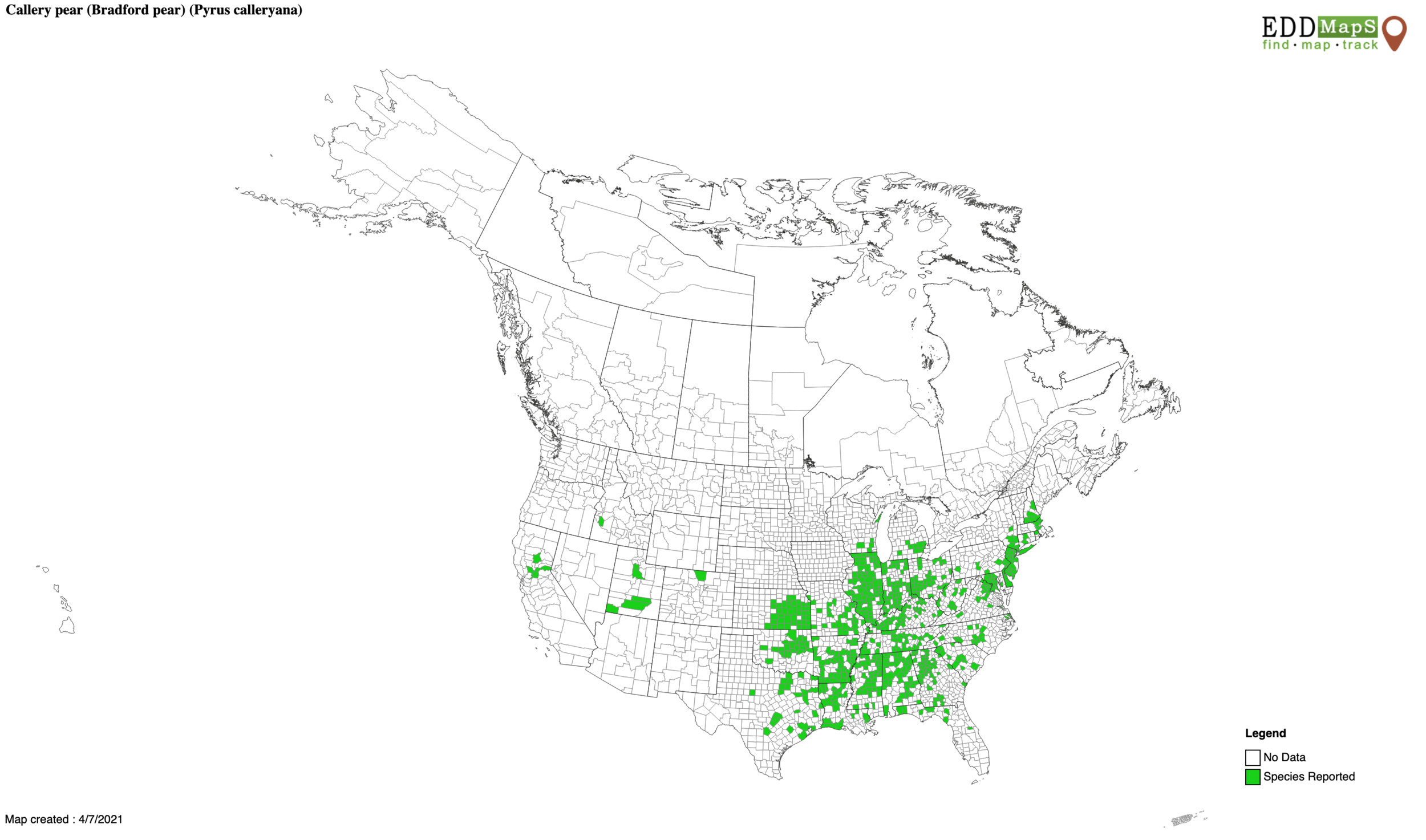April 2021 Invasive Plant of the Month
SICIM Email
Callery Pear (Pyrus calleryana)
Callery pear (Pryus calleryana) is a medium-sized, rapid growing, deciduous tree in the rose family (Rosacea) that was introduced to the US from Asia in the early 1900s. The ‘Bradford’ and ‘Chanticleer’ pear are some of the common cultivars. These and other cultivars have been commonly used as ornamentals due to their showy white flowers in early spring and colorful fall foliage. Originally thought to be sterile, we now know these cultivars can cross-pollinate and produce fertile fruit, which is eaten by birds, who then disperse the seeds widely. Callery pear readily colonizes both disturbed sites and natural areas alike, forming dense thickets. Despite being ranked as a highly invasive plant species, it is still used across the state as an ornamental tree in landscaping and sold at nurseries.
IDENTIFICATION & BIOLOGY: Callery pear is a deciduous tree that can grow up to 60 ft (18 m) in height and 2 ft (0.6 m) in diameter. Flowers are showy, white in color, malodorous, have 5 petals and are 1 in wide. They appear in early spring (April to May) before leaves emerge, and are insect pollinated. Fruits are round, typically 0.5 in in diameter (although this can vary), and green to brown in color. Leaves are alternate, simple, 2-3 in long, petiolate, shiny with wavy, slightly toothed margins, and turn a dark red color in the fall. Though most cultivars lack thorns, escaped Callery pear infestations often revert to wild-type, growing in thickets and producing thorn-like branches. It is fast-growing, but rather short-lived (30-50 years) tree and its poor branching structure is prone to ice and storm damage.
LOOK-A-LIKES: There are native serviceberry, plum, and crabapple species that bloom about the same time as Callery pears, and all have five-petaled whiteish flowers. Serviceberry petals are brighter white, star-shaped and wavy with space between, as opposed to rounded and close together for the invasive ornamental pear. Native plums have stamens that are longer than the petals. Apple and crabapple flowers can vary from white with a pinkish hue to fully pink, and apple tree branches are nearer to horizontal and less uniform compared to the vertical, symmetrical branching of Callery pear.
HABITAT & DISTRIBUTION: Callery pear has been found in various disturbed habitats, including degraded open woodlands, woodland borders, thickets, fence rows, and fallow fields. This invasive tree adapts to full or partial sun, moist to dry-mesic conditions, and soil containing loam, clay-loam, or sandy loam and is somewhat drought tolerant. The pH of the soil can be acidic to alkaline. Winter cold is tolerated to Zone 5. It is commonly spotted growing along roadsides and in fallow farm fields. Callery pear has rapidly spread throughout Indiana and the eastern US and is rapidly spreading through other midwestern as well as western states.
ECOLOGICAL THREAT: Callery pear and its cultivars can cross-pollinate to produce fertile fruit, which is eaten by birds, who then disperse the seeds widely. Additionally, fertile pear varieties are commonly used as the rootstock when grafting, and if the grafted crown is damaged the fertile rootstock can then dominate, producing viable fruit. Once established Callery pear forms dense thickets that push out other plants including native species that can’t tolerate deep shade or compete for water, soil and space. Because it can adapt to a wide variety of conditions, it is a significant threat to native grasslands and grassland wildlife, but also invades forested areas. In urban and landscaped areas, it poses a threat because it is a weak tree that is easily damaged by ice and wind, commonly resulting in utility outages, property damage, and safety hazards.
CONTROL:
Prevention - The first priority to limit the spread is to stop the use of Callery pear or any of the cultivars in ornamental landscape plantings and remove it from any existing intentional plantings.
Manual - Seedlings and shallow-rooted plants can be pulled when soil is moist. Unless completely uprooted, herbicides will be needed. Since Callery pear is a vigorous resprouter, mowing is not an effective control method. Bag and dispose of fruit as solid waste or burn.
Chemical – Medium to large trees should be cut down and stumps treated with a high concentration, low volume systemic glyphosate or triclopyr-based herbicide. If cutting down is not feasible, medium to large trees can also be killed via girdling and left standing, making sure to chemically treat cuts. Any cutting or girdling of trees without chemical treatment will cause them to resprout heavily. It is important to avoid cut surface treatments in spring when sap is flowing during flowering and leaf out. Trees less than 6 inches in diameter at the base can be killed with an oil-based basal bark treatment (BBT). Due to risk of injury and property damage from falling limbs or snags, any treatments that leave medium to large dead trees standing should be avoided in areas near structures, along roadways, or in locations that are frequented by people, pets, and livestock. Newly established trees and resprouts can be sprayed with a foliar herbicide such as triclopyr. Callery pear are prolific seed producers, with saplings producing fruits as early as three years of age, such that continued control will likely be required.
IMPORTANT: The pesticide label is the law! When using any chemical control, always read the entire pesticide label carefully, follow all mixing and application instructions and use all personal protective gear and clothing specified. Contact the Office of Indiana State Chemist (OISC) for additional pesticide use requirements, restrictions or recommendations.
ALTERNATIVES TO PLANT: American plum (Prunus americana), flowering dogwood (Cornus florida), Eastern redbud (Cercis canadensis), hawthorn (Crataegus spp.), downy serviceberry (Amelanchier arborea)
CALLERY PEAR HANDOUT: https://www.invasive.org/weedcd/pdfs/wow/callery_pear.pdf
REFERENCES & OTHER RESOURCES:
https://extension.okstate.edu/fact-sheets/the-invasive-callery-pear.html
https://www.illinoiswildflowers.info/trees/plants/callery_pear.htm
https://www.invasive.org/alien/pubs/midatlantic/midatlantic.pdf
https://www.invasive.org/gist/products/handbook/methods-handbook.pdf
http://www.misin.msu.edu/facts/detail/?project=misin&id=126&cname=Bradford+pear
https://mdc.mo.gov/sites/default/files/downloads/callerypearinvasive.pdf
LOOK-A-LIKE REFERENCES:
https://mdc.mo.gov/sites/default/files/downloads/callerypearinvasive.pdf
https://www.illinoiswildflowers.info/trees/plants/wild_crab.htm
#callerypear #bradfordpear #pyruscalleryana #ornamentalpeartree #indianainvasiveplants #indianainvasviesinitiative






